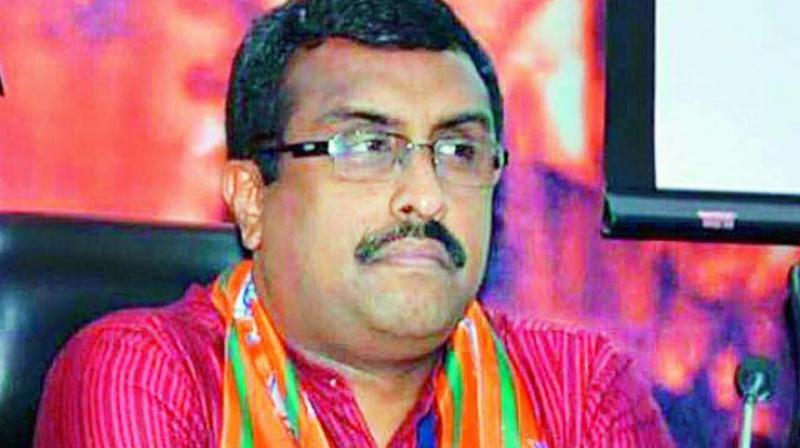BJP has NDA, Cong fought UPA allies: Now what?

My cousin Jimmy, with minimum stakes in the system, has set himself up as the family’s Cassandra, constantly predicting disasters. Sometimes when pessimism possesses all of us, we turn to him for confirmation. After senior RSS leader Ram Madhav hinted at a coalition situation for the BJP, the eager beavers among us concluded that the BJP was plummeting. For confirmation we turned to the Oracle, Jimmy. He closed his eyes tightly, like he had travelled into an imaginary distance. He then opened his eyes slowly and, with a wave of the hand, declared: “Yeh aisey naheen to waisey aayenge.” (If they don’t come back to power this way, they will come that way.) The system, if not the people, will bring them back, said he. Should we defer to him?
He did not torment us for long. We soon began to receive calls from our BJP contacts — the party is doing badly here, not too well there and so on.
If the nightmare does end for the Leftists, liberals, dalits and Muslims, many will be justified in heaving a sigh of relief. The experience will be like the post-Emergency relief. In fact, to quote Mamata Banerjee, “this is maachh, maachh, maachh, worse than the Emergency”.
Nasty ingredients like hatred, revenge, forced ghar wapsi, lynching were not part of the impulse which had led to the Emergency. In fact, Indira Gandhi was being buffeted by East-West ideological currents, externally and internally. Remember the 1970s were going badly for the West. Against that global backdrop, Indira Gandhi had split the Congress, then clasped the Soviet hand tightly for the liberation of Bangladesh.
Sripad Amit Dange, CPI leader, Mohan Kumaramanglam, a Communist-inclined Union minister, and P.N. Haksar, her Left-leaning principal secretary — these were among her closest advisers. The global Right and its Indian sympathisers clustered around Jayaprakash Narayan’s Bihar movement in 1974. Senior RSS leader Nanaji Deshmukh was the master strategist for this movement.
What Indira Gandhi called the “jute press” was stacked against her. Concerted pressure was beginning to unnerve her when the Allahabad high court judgment, unseating her from Parliament, caused her to impose the Emergency. For this she was routed in 1977. But Indira Gandhi appeared to have been chastened into Hinduism once she returned to power in 1980. Operation Bluestar was launched in this mood, which eventually led to her assassination, followed by the anti-Sikh pogrom of 1984.
When Rajiv Gandhi won the 1984 election with 414 seats in a House of 543, the party extracted two conclusions from the outcome. First, it was a sympathy wave because of Mrs Gandhi’s murder. Second, it was also Hindu consolidation against Sikh minority communalism. The Congress leadership began to strategise on the basis that Hindu sentiment had to be respected. Opening of the temple locks, permitting the brick-laying ceremony for the Ram temple, promising “Ram Rajya” if the Congress won the 1989 elections and so on — were all dictated by this thinking. So, Rahul Gandhi’s current temple-hopping has antecedents.
The BJP, smarting under the fact that it had been reduced to just two seats in Parliament in 1984, began to worry more when it saw the Congress stealing its “Hindu” platform. By way of damage control, the party elected Lal Krishna Advani as its president in 1986. After the 1989 elections, Prime Minister Vishwanath Pratap Singh implemented the Mandal Commission report reserving government jobs for Other Backward Castes (OBCs). This aggravated the intra-Hindu caste conflict. The Hindu caste pyramid was in a state of high agitation when Mr Advani undertook his rathyatra to Ayodhya to highlight the urgency of the Ram temple being built. This was to neutralise the effects of Mandal. The Ram Janmabhoomi-Babri Masjid issue evolved as a Hindu-Muslim conflict, no doubt, but its purpose was far more complex.
Hindu consolidation, with Muslims as the other, would, over a period of time, mobilise Hindus on the lower rungs of the caste hierarchy against the Muslim “other”. Instead of weakening the Hindu structure by falling prey to caste politics, the lower castes were being accorded a place of honour as Hindu foot soldiers, a powerful infantry of the Hindutva brigade. Communalism, in other words, was to be a strategy to stabilise the caste pyramid.
Vigorous social engineering towards this end was launched by an energetic RSS functionary, K.N. Govindacharya, in the 1990s. This is what the Congress has set itself up against without any social engineering. They both have a Muslim policy, equally harmful to the community, but one’s approach is quite distinct from the other’s. The BJP is on a no-holds-barred anti-Muslim mobilisation spree. The Congress, scared to lose Hindu votes, simply keeps Muslims out of the frame. “Willing to wound, and yet afraid to strike” describes it best.
Thinking on its feet mostly, the Congress imagines that it is reinventing itself as an upper caste party, which once had under its canopy Muslims and dalits as well. The dalits, of course, now have their own caste parties. Muslims are shuttling between caste parties and anyone, even the devil, if he can help to keep the BJP out.
It is instructive for the Congress to realise that Indira Gandhi’s Emergency was an aberration in a settled world order. It embarrassed Mrs Gandhi herself, which is why she had called for elections. Narendra Modi’s excesses are in a world order up to its waist in fascism.
Will he fit into this order? Unlikely, because he has to grapple with India’s infinite variety. Geert Wilders can dream of a future in fascism for tiny Netherlands. But Mr Modi has to dream unrealistically of imposing uniformity on a multilingual, multi-regional, multi-religious subcontinent, not yet a classical nation state.
That is why the dream of the Indian middle class that India is about to become a two-party system, both parties representing upper castes, will remain just that — a dream. India will survive and thrive in its strong federal framework. Jimmy, in this model, must be allowed the freedom to ring his alarm bells. Who knows, he may cry wolf one day after really having seen one.

